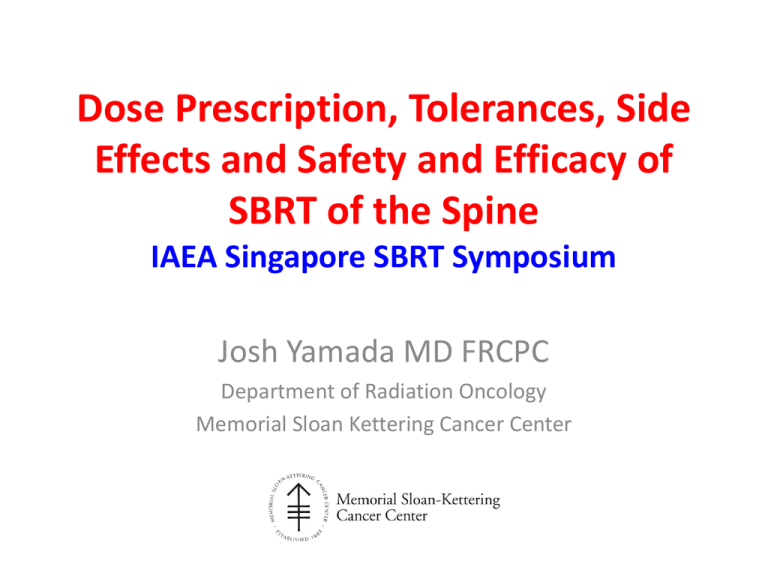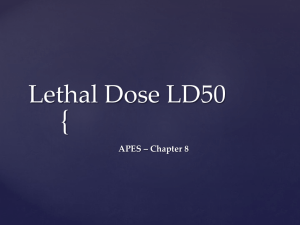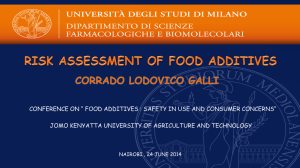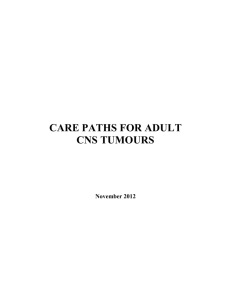
Dose Prescription, Tolerances, Side
Effects and Safety and Efficacy of
SBRT of the Spine
IAEA Singapore SBRT Symposium
Josh Yamada MD FRCPC
Department of Radiation Oncology
Memorial Sloan Kettering Cancer Center
Spinal Cord Radiation Injury
Type
Timing
after XRT
Clinical
Findings
Pathogenesis
Outcome
Acute
During XRT
None
--
--
Early-Delayed
2-37 Weeks
Lhermitte’s
Demyelination
Recovery
Late Delayed
Months-Years
Para/Quadriple
gia
Brown-Sequard
Spastic
paraparesis
Necrosis
Irreversible
Leg Weakness
Ventral roots
Irreversible
Acute
paraparesis
Telangectasia
Reversible
Transverse
myelopathy
Motor Neuron
Dysfunction
Hemorrhagic 8-30 years
myelopathy
From: Posner J, Neurologic Complications of Cancer, p 525
Progressive Myelopathy
• Demyelination, necrosis, BBB disruption
• 12-50 months post XRT
• Slowly progressive symptoms
– Brown Sequard syndrome with paraethesia
and weakness in one side and decrease in
pain/temp in side, progressing to transverse
myelitis
– Progressive weakness, hyperactive reflexes,
loss of position and vibration, pain and temp
intact
– Decreased motor conduction velocity
– CSF usually N, or increased protein.
– MRI: Cord swelling and patchy enhancement
Spinal Cord Tolerance
Institution
Dose Constraint
MSKCC
14 Gy Dmax
UPMC
10 Gy Dmax
HENRY FORD
V10Gy < 10%
MDACC
12 Gy Dmax TO 0.1 CC
PMH
12 Gy Dmax TO THECAL SAC OR CORD + 2mm
CLEVELAND CLINIC
14Gy Dmax AND V10Gy <10%
STANFORD
14 Gy Dmax, V12Gy < 0.3 CC, V10Gy < 0.5 CC V8Gy < 1 CC
DALLAS
14 GY Dmax, V10Gy < 0.35CC, V8Gy < 1.2CC
Background
• Dose-volume tolerances of the spinal cord in
spinal stereotactic radiosurgery (SRS) have
been difficult to define
– Complication rates required to be very low
– Published reports of myelopathy do not account
for the total number of patients treated at given
dose-volume combinations
Purpose
• Report spinal cord toxicity from single fraction
spinal SRS
• Provide a comprehensive atlas of complication
incidence to identify dose-volume predictors
of spinal cord toxicity
Materials and Methods
• Prospective database of all patients treated
with single fraction SRS between 2003-2010
• Retrospective review for spinal cord toxicity
• No prior radiation to region allowed
• Spinal Cord Toxicity
– Clinical Myelitis
– MRI spinal signal changes not attributable to
tumor progression or other causes
Materials and Methods
• DVH atlases were created
• Complication rates with 95% confidence limits
• Probabilities that complication rates were <
1% for myelitis and < 10% for signal changes
were determined as a function of dose and
absolute volume.
Results: Cohort Characteristics
Patients
Total number of lesions
≥ 2 treatment sites
Signal information p tx
n
221
251
30
203
Percent
100%
100%
15%
92%
Gender
Female
Male
87
134
40%
60%
Age (years)
Median
Range
Baseline KPS
Median
Range
Spinal Region
Cervical
Thoracic
Lumbar
Follow-Up (months)
Median
Range
Status at Last Follow-up
Alive
Deceased
60.2
20-86
90%
50% - 90%
46
196
9
18%
79%
3%
15
3-81
98
123
44%
56%
Primary Tumor Site
Breast
Upper GI (esoph, pancreas, gallbladder)
Lower GI (anal, rectal, colon)
Hepatocellular
Sarcoma
Melanoma
Lung
Prostate
Renal Cell
Other GU (penile, testicular, bladder)
Thyroid
H&N SCC
CNS
Other
n
Percent
13
4
14
9
30
13
22
24
40
5
15
7
10
15
6%
2%
7%
4%
14%
6%
10%
11%
18%
2%
7%
2%
4%
7%
Histological Category
Adenocarcinoma
Carcinoma
Melanoma
Sarcoma
Other
Prescribed Dose
1800 cGy
2100 cGy
2200 cGy
2300 cGy
2400 cGy
Median (cGy)
Mean (cGy)
33%
37%
7%
14%
9%
6
21
4
1
219
2400
2356
2%
8%
2%
< 1%
87%
Spinal Cord Toxicity with Single
Fraction Paraspinal SRS
• One case of clinical myelitis (0.4%)
• 5 cases of signal changes without clinical signs
or symptoms of myelopathy (2.4%)
Spinal Cord Toxicity with Single
Fraction Paraspinal SRS
• All myelitis or signal changes:
– Maximum cord dose > 13.33 Gy
– Minimum doses to the hottest:
•
•
•
•
0.1 cc > 10.66 Gy
0.2 cc > 10 Gy
0.5 cc > 9 Gy
Vol
v(cc)
1 cc > 8 Gy
0
0.1
0.2
0.5
1
Myelitis
Dose
#
#
99% conf
Signal Changes
prob
#
#
99% conf
prob
d(Gy) comp tot lim on r
r < 1%
comp tot lim on r
r < 10%
13.33
0 64
0.068
0.49
0 55
0.079
1.00
10.66
0 60
0.073
0.47
0 51
0.085
1.00
10
0 56
0.078
0.45
0 46
0.093
0.99
9
0 45
0.095
0.38
0 36
0.117
0.98
8
0 26
0.157
0.25
0 30
0.138
0.96
Statistics for treatments with DVHs passing below the locations (v,d), chosen just below the Myelitis DVH.
95% confidence limit on signal changes
rate for DVHs passing above plot point
95% confidence limit on signal changes rate
for DVHs passing above plot point
0.05
16
0.10
signal changes
myelitis case
0.15
0.20
0.25
14
0.30
0.35
0.40
12
0.45
0.50
Volume (cc)
0.55
0.60
10
0.65
0.70
0.75
8
0.80
0.85
0.90
0.95
6
4
2
0
0
2
4
6
8
Dose (Gy)
10
12
14
Myelitis:
Probability that True
Complication
myelitis
probability that true complication rate > 2%
Rate > 2%
16
0.05
0.10
0.15
0.20
0.25
0.30
0.35
0.40
0.45
0.50
0.55
0.60
0.65
0.70
0.75
0.80
0.85
0.90
0.95
1.00
myelitis case
cord volume (cc)
14
12
10
8
6
4
2
0
0
2
4
6
8
dose (Gy)
10
12
14
Cord Signal Changes:
Probability that True
Complication
signal changes
probability that true complication rate > 5%
Rate > 5%
0.05
16
signal changes
myelitis case
0.10
0.15
0.20
0.25
14
0.30
cord volume (cc)
0.35
0.40
12
0.45
0.50
0.55
0.60
10
0.65
0.70
0.75
8
0.80
0.85
0.90
0.95
6
4
2
0
0
2
4
6
8
dose (Gy)
10
12
14
Conclusions
• High dose paraspinal SRS has a low rate of
clinical apparent myelopathy (<1%)
• Asymptomatic spinal cord signal changes are
more common (2%)
• The following dose limits minimize the
potential for spinal cord toxicity after SRS
– Maximum cord dose < 13.3 Gy
– Minimum doses to the hottest 0.1, 0.2, 0.5, and 1
cc < 10.66, 10, 9, and 8 Gy respectively
Future Directions
• Pooled multi-institutional effort to overcome
limitations
– Single institution cohort with homogeneously
treated population
– Limited events
Cord Myelopathy Dosimetry
Case 1
Case 2
Case 3
Case 4
MSKCC
Total Dose (Gy)
25
24
16
16
NA
Prescription Line
80%
70%
90%
90%
NA
Fraction Number
2
3
1
1
NA
PTV Volume (cc)
14.6
7.6
66
10.8
NA
V100%
96
98
95
99
NA
D100 (Gy)
22
21
11
15
NA
D90 (Gy)
26
25
16
15
NA
Level
T Spine
C Spine
Clivus
Clivus
NA
Time to Sx (Mon)
9
9
13
?
NA
Gy2
190
190
122
136
112
Cord Dmax BED Gy2(1)
18.5
18.5
14.6
15.6
14.0
Cord Dmax BED
Yucatan Mini Pig Reirradiation
Medin et al. IJROBP 2010
• 23 mature mini pigs received 3000cGy/10
• Single Fraction Spine SRS one year later
Dose
14 Gy
16 Gy
18 Gy
20 Gy
22 Gy
24 Gy
N
2
3
5
5
5
3
Deficit
0
0
2
4
5
3
FU
40 weeks
52 weeks
48-52 weeks
52 weeks
20 weeks
14-19 weeks
Pig Cord Reirradiation Histopathology
• No changes at 14-16 Gy
• 18-20 Gy changes limited to small foci of
demyelination
• 22-24 Gy extensive tissue damage including
grey matter infarction
• Pigs reirradiated with SRS one year after
3000cGy/10 no different that pigs receiving de
novo SRS.
Pig Cord ED50
• 96% calculated recovery after 3000cGy/10
after one year.
Vertebral Body Fracture Risk
Vertebral body involvement is a significant risk for fracture (p=0.02)
Percent
vertebral body
involvement
0-20
21-40
41-60
61-80
81-100
New or progressive fracture
No
Yes
14
5
1
1
2
4
7
6
5
1
Percent with
new or
progressive
fracture
22
58
86
83
33
• Not found to be significant risk factors:
• Obesity, posterior element involvement, local kyphosis, pre-exisiting endplate
infraction or fracture,
• XRT dose
•
N = 114 patients
•
FU = 10.9 months (median)
•
Grade 2 N= 5, Grade 3 N= 1, grade 4 N= 1
Esophagus
Constraints
Level 1
< 15 Gy/2cc
Level 2
< 20 Gy/2cc
Progressive risk of vertebral body
fractures post high dose IGRT
63 year old female with NSCLC acute onset of back pain post 2400cGy to T5
10-O6
3-O7
3-O7
Methods
• 71 treated sites in 62 consecutive patients with solid
tumor spine metastases
• 1800-2400 cGy single fraction IGRT
• Serial MRI every 3-4 months
• All images reviewed by same 3 spine surgeons and
neuroradiologist
• Primary outcome: New fracture or progression of exisiting
fracture
• Secondary outcomes:
– ASIA score
– VAS pain score, narcotic use
Results
• Fracture/progression noted in 27 sites (39%)
• 65% lytic, 17% mixed, 18% sclerotic
• Lytic lesions were 6.8 times more likely to fracture vs.
mixed/sclerotic lesions (p<0.001)
Percent
vertebral body
involvement
0-20
21-40
41-60
61-80
81-100
New or progressive fracture
No
Yes
14
5
1
1
2
4
7
6
5
1
Percent with
new or
progressive
fracture
22
58
86
83
33
Lytic vs. Non Lytic
Function and Symptoms
• Fracture/progression not correlated with
– BMI
– XRT dose
• ASIA score not impacted
• Median VAS score in fracture patients 5 vs 2 in
non fracture patients (p=0.051)
• Fracture patients more likely to use narcotics
(70% vs. 41% p = 0.005)
Conclusions
• A high risk of radiographic vertebral body fracture
was found after high dose single fraction radiation
– Dose not a significant predictor
– Lytic lesions and greater tumor involvement were found to
be risk factors
– ASIA score not affected
– Patients with fracture were found to report more pain and
require more narcotics
• High dose radiation may contribute to the
development of vertebral body fracture
• Currently investigating the role of prophylactic
kyphoplasty in highest risk patients
Materials & Methods
• 204 consecutive spinal metastases abutting the
esophagus in 182 patients were treated with single
fraction paraspinal SRS at MSKCC between 20032010
• Esophageal toxicity scored with NCI CTCAE 4.0
• Atlases of complication incidences were generated
• Clinical factors were correlated with toxicity
Cohort Characteristics
Patients
Lesions
Patients ≥ 2 treatment sites
n
182
204
28
Percent
100%
100%
15%
Gender
Female
Male
73
109
40%
60%
Age (years)
Median
Age
Baseline KPS
Median
Range
Spinal Region
Cervical
Thoracic
Follow-Up (months)
Median
Range
Status at Last Follow-up
Alive
Deceased
61
21-88
90%
50% - 90%
26
178
13%
87%
12
3-81
102
80
56%
44%
n Percent
Primary Tumor Site
Breast
Upper GI (esoph, pancreas, gallbladder)
Lower GI (anal, rectal, colon)
Hepatocellular
Sarcoma
Melanoma
Lung
Prostate
Renal Cell
Other GU (penile, testicular, bladder)
Thyroid
H&N SCC
CNS
Other
Prescribed Dose
1600 cGy
1800 cGy
2100 cGy
2200 cGy
2300 cGy
2400 cGy
Median cGy
11
4
13
8
25
12
18
20
33
3
13
3
7
12
6%
2%
7%
4%
14%
6%
10%
11%
18%
2%
7%
2%
4%
7%
1
24
10
3
1
165
< 1%
12%
5%
1%
< 1%
81%
2400
Esophageal Toxicity with Single
Fraction Paraspinal SRS
n
n
Percent
Percent
Late Toxicities
Acute Toxicities
Overall
31
15 %
Overall
24
12%
Grade
Grade
Grade
Grade
28
1
2
0
14%
< 1%
1%
0%
Grade
Grade
Grade
Grade
13
6
4
1
6%
3%
2%
< 1%
28
2
1
90%
7%
3%
12
4
4
4
50%
17%
17%
17%
1-2
3
4
5
Esophagitis/Pain
Esophageal ulcer
Esophageal edema
1-2
3
4
5
Esophagitis/Pain
Esophageal stenosis
Esophageal fistula
Esophageal ulcer
Patients with Grade ≥ 3 Toxicity
n
Time Grade
Site
Dose Toxicity Class
(cGy)
1
2
3
Acute
Acute
Acute
T2-3
T4
C7
2100
2400
2400
3
4
4
Median
4
5
6
7
8
9
10
11
12
13
14
Late
Late
Late
Late
Late
Late
Late
Late
Late
Late
Late
3
3
3
3
3
3
4
4
4
4
5
Median
Esophagitis
Esophagitis
Ulcer
2400
C5
T2-T4
T2-T3
C7-T1
C6-T1
T6
T3
T3
T7
C4-T2
T2
2200
2400
2400
2400
2400
2400
2400
2400
2400
2400
2100
2400
Time to
Maximum
Toxicity
(days)
54
65
84
65
Stenosis
Stenosis
Ulcer
Stenosis
Stenosis
Ulcer
Fistula
Fistula
Fistula
Ulcer
Fistula
245
178
350
395
346
132
444
149
380
128
584
346
Dosimetric and Volumetric Predictors
of Grade ≥ 3 Esophageal Toxicity
Dosimetric
Variable
Median
Split
Toxicity
Incidence
Below
Median Split
n
%
Toxicity
Incidence
Above
Median Split
n
%
RR Grade ≥ 3
Toxicity
p value
D2.5 cc
14.02 Gy
2/102
2%
12/102
12%
12/2 = 6
0.01
V10
V12
V15
V20
V22
4.77 cc
3.78 cc
1.87 cc
0.11 cc
0.0 cc
4/102
3/102
1/102
2/102
1/102
4%
3%
1%
2%
1%
10/102
11/102
13/102
12/102
13/102
10%
11%
13%
12%
13%
10/4
11/3
13/1
12/2
13/1
0.16
0.05
0.0013
0.01
0.0013
Gy
Gy
Gy
Gy
Gy
=
=
=
=
=
2.5
3.7
13
6
13
Atlas of Complication Incidence for
Grade ≥ 3 Acute or Late
Esophageal Toxicity
Probability the true complication rate > 10%
0.0
0.1
0.2
0.3
0.4
0.5
0.6
0.7
0.8
0.9
1.0
Esophagus Volume (cc)
14
12
10
8
6
4
2
0
0
5
10
15
Dose (Gy)
20
25
30
Dose Response Model for Grade ≥
3 Esophageal Toxicity
Prob. of >= grade 3 esoph. comp.
Dose Response for >= Grade 3 Esophagitis
Single Fraction Treatments
0.3
logistic fit
observed rate (quartiles)
0.2
0.1
p < 0.0006
0.0
0
5
10
15
20
Dose to hottest 2.5 cc (Gy)
25
30
Clinical Risk Factors for Developing
Grade ≥4 Esophageal Toxicity
n
Site
Dose
(cGy)
Time
1
T4
2400
Acute
4
Esophagitis
2
C7
2400
Acute
4
Ulcer
3
T3
2400
Late
4
4
5
T3
T7
2400
2400
Late
Late
6 C4-T2
2400
7
2100
T2
Grade Toxicity Class
Probable
Radiation
Recall
Reaction
(Agent)
Adriamycin
Iatrogenic
Time to
Manipulation Maximum
Before
Toxicity
Maximum
(days)
Toxicity
-65
Biopsy
84
Fistula
Liposomal
Adriamycin
--
Dilation
444
4
4
Fistula
Fistula
-Gemcitabine
Biopsy
Stent
149
380
Late
4
Stenosis
Adriamycin
Dilation
128
Late
5
Fistula
--
Stent
584
Grade IV Esophageal Fistula
•
•
•
•
•
•
45 year old male
Oligometastatic RCC
Symptomatic T3 lesion
2400 cGy
Cord Dmax < 14 Gy
Esophagus 15 Gy / 2 cc
Grade IV Esophageal Fistula
•
4 months: Grade 2 esophageal pain
•
4.5 months: EGD
• 3 cm non bleeding ulcer @ 22 cm
• Cold forceps biopsy
•
6 months: Worsening pain
• Increased ulceration with superinfection
• ¾ circumference with moderate stenosis
• Dilation and cold forceps biopsy
•
6.5 months: Acute development of TEF
• Multiple repairs and stent procedures
•
11 months: Expired from distant progression
Conclusions
•
High dose, single fraction paraspinal SRS has a low rate of
grade ≥ 3 esophageal toxicity
•
Careful attention to esophageal doses minimizes toxicity
•
MSKCC: 2.5 cc of esophagus ≤ 14 Gy
•
Radiation recall reactions and iatrogenic manipulation of the
irradiated esophagus predispose for development of grade ≥
4 toxicity
Toxicity Summary
• Spinal cord injury at current dose levels is
extremely rare
– Poor statistics because of limited events
• Vertebral body injury is common after spine
SBRT
– Radiographic 40%
– Symptomatic 15-20%
• Esophageal injury is most common and very
worrisome complication











